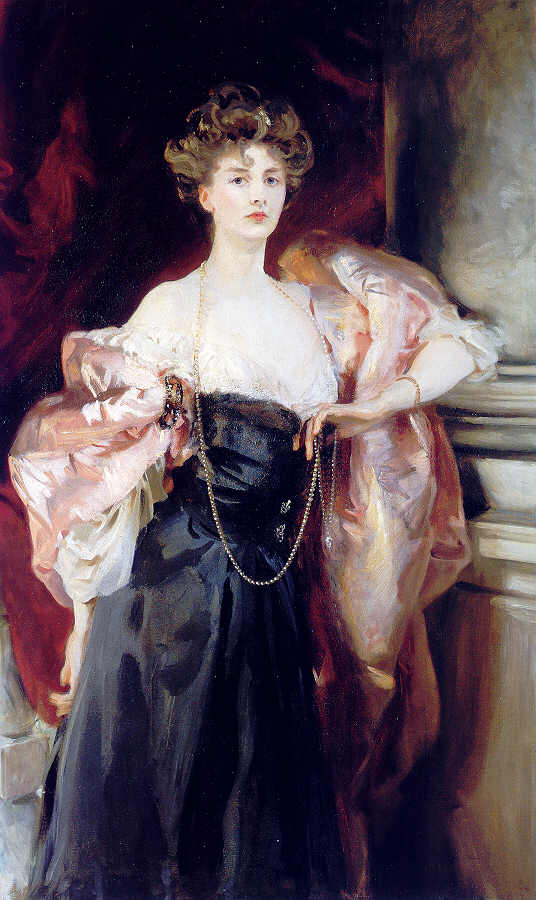 |
 |
|
The painting was done in Venice at a palazzo. The Grand Cannel can be seen through the rail. From: Lora Premo (l premo 17@comcast.net) Date: Thu, 28 Oct 2004 Natasha, I'm pretty sure that Lady Helen Vincent is not "nee D'Abernon" [as was previously stated below]. I believe that her husband, Lord D'Abernon, was elevated from the status of Sir Edgar Vincent to Lord D'Abernon, so she would be decribed as Lady Helen Vincent, later D'Abernon. Here is her entry from the National Archives: "Vincent, Helen Venetia (d 1954) nee Duncombe, wife of Viscount D'Abernon (2)" I have read in the Countess of Fingalls' memoirs, Seventy Years Young, that Hermione, Duchess of Leinster, one of the most beautiful women of the day, was Helen D'Abernon's sister. I have not found absolute confirmation of that on the internet (DeBrett's would probably have it), but the fact that Helen's maiden name was Duncombe, like Hermione's, would seem to confirm it. Certainly Helen was extraordinarily lovely, too.
Lady Helen Vincent "mug" Note:
Subject: Lady Helen Vincent Bio ? From: Dr Sylvia Kahan S kahan pf@aol.com Date: 5/7/2001 I am a musicologist at City University of New York. My current project is a biography of the French-American arts patron the Princesse Edmond de Polignac. Sargent painted her portrait [prior] in 1889 when she was the Princesse de Scey-Montbeliard [aka Winnareta Singer] What I'd like to know is if you have any information about Lady Helen Vincent nee d'Abernon [sic she would marry d'Abernon], the subject of two Sargent portraits from 1904 and 1905. Just a thumbnail sketch of who she was would be greatly appreciated. Sincerely,
From: Natasha I wish I could help you, the Birmingham Museum of Art had a brief bio on her but the page as gone bad and I can't find it. I would write to them. If they respond, let me know The Smithsonian Institution Research Information site also shows Edmond de Polignac, Princesse; also known as Winnareta Singer which Sargent knew when he was living in Paris. (see Madame
Errazuriz) From:
Dr.
Sylvia Kahan Dear Natasha, I'm pleased to tell you about the release of my book on the Princesse de Polignac, "Music's Modern Muse" (University of Rochester Press, 2003). It goes without saying that JS Sargent figures in the story fairly frequently. The American-born Winnaretta Singer (1865-1943) was a millionaire at the age of eighteen, due to her inheriting a substantial part of the Singer Sewing Machine fortune. Her 1893 marriage to Prince Edmond de Polignac, an amateur composer, brought her into contact with the most elite strata of French society. After Edmond's death in 1901, she used her fortune to benefit the arts, science, and letters. Her most significant contribution was in the musical domain: in addition to subsidizing individual artists (Boulanger, Haskil, Rubinstein, Horowitz) and organizations (the Ballets Russes, l'Opéra de Paris, l'Orchestre Symphonique de Paris), she made a lifelong project of commissioning new musical works from composers, many of them unknown and struggling, to be performed in her Paris salon. The list of works created as a result is long and extraordinary: Stravinsky's Renard, Satie's Socrate, Falla's El Retablo de Maese Pedro, and Poulenc's Two-Piano and Organ Concertos are among the best-known titles. In addition, her salon was a gathering place for luminaries of French culture such as Proust, Cocteau, Monet, Diaghilev, and Colette. Many of Proust's memorable evocations of salon culture were born during his attendance at concerts in the Polignac music room. Singer-Polignac supported the work of several women composers, including Ethel Smyth and Adela Maddison, using her influence to have their operas mounted in major European theaters. She also was a patron of the Ballets Russes [see also Tamara Karsavina] and the composers whose music became associated with the troupe's productions. Sylvia Kahan brings to life this eccentric and extravagant lover of the arts, whose influence on the 20th Century world of music and literature remains incalculable. Sylvia Kahan, a pianist
and scholar,
is on the faculties of the City University of New York's Graduate
Center
and College of Staten Island. At the latter, she serves as Chair of the
Department of Performing and Creative Arts |
